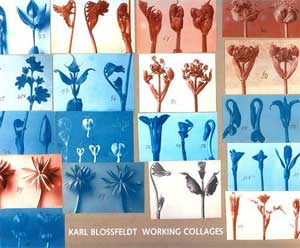 Karl Blossfeldt: Working Collages Karl Blossfeldt: Working Collages
ed. Ann and Jurgen Wilde
The MIT Press, $55.00
(ISBN 0-262-02501-9)
By Robert Hirsch
From Vol. 2 No. 2

Karl Blossfeldt (1865-1932) used macro- and microscopic photography to present the "artistic" organizing patterns in nature (Art Forms in Nature, 1929). This pioneer of the New Objectivity movement of the 1920s and 1930s wanted to eliminate atmospheric effects and personal reactions to reveal a subjectís basic design and demonstrate that "Nature is our best teacher." Through enlarging discrete portions of a subject - the characteristics, details, patterns, and textures that would otherwise go unobserved by human vision or in normal-range photography - Blossfeldt made the imperceptible perceptible. By removing all nonessentials and dispensing with recreating a psychological mood or a social relationship, he wanted to show that art and nature are so "intimately bound up as to be inseparable."
The discovery of sixty-one unknown collages on gray cardboard in 1997 adds insight into how Blossfeldt apparently used these multiples as part of his systematic approach to study the relation and similarity of plant forms and wrought iron shapes. This sketchbook of brown gelatin silver prints, cyanotypes, and gray gelatin silver chloride prints takes on a rhythmic repetition as the comparative anatomy of each motif comes to the fore. They are looser than his final singular compositions and offer a wider contextual window to his archivist approach of showing an archetypal plant structure. Blossfeldtís inventory style influenced the modern typology movement of German photographers Bernd and Hilla Becher and their students like Andreas Gursky. RH
|